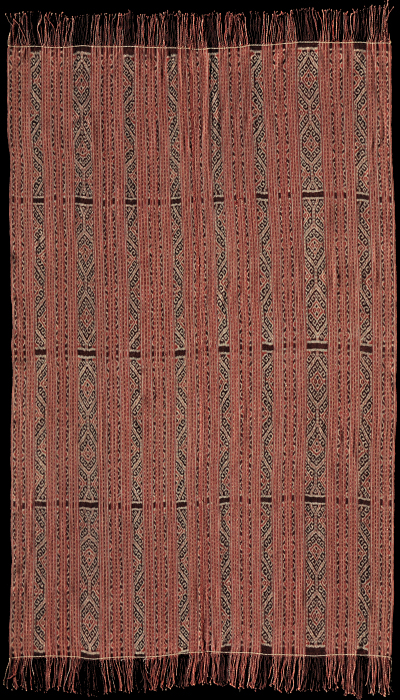| |
 
 | | | |
177 Timor, West Timor
Beti naek (men's wrap)  
| | Locale: | Biboki, Insana district. Atoin Meto (Atoni) people. | | Period: | 1930-1950 | | Yarn: | Cotton, hand-spun, medium | | Technique: | Warp ikat | | Panels: | 2 | | Size: | 127 x 182 cm (4' 2" x 5' 11") LW: 1.43 | | Weight: | 1040 g (36.7 oz), 450 g/m2 (1.47 oz/ft2) | | Design: | The two widest bands are decorated with the traditional kaif pattern, which stands for connections with the ancestors. The six narrow bands are of the same design, but sliced in half lengthwise and juxtaposed in such a way that they would form a complete pattern if they were not separated by either a band with a full kaif pattern, or the seam. The main motif, consisting of linked hexagons, is also seen to the east, both in Timor-Leste's Covalima and in the Babar Islands. Tightly twisted fringes. | | Comment: | Rare older Biboki beti, using traditional methods only. Heavy, manly cloth. While commercial yarns and chemical dyes were adopted in Biboki fairly early on, this piece is 'full asli': made of hand spun yarns, using vegetable dyes. There is one tiny hole, not affecting the motif, otherwise the piece is in excellent state of preservation. Strong smell of decomposing indigo attests to its advanced age, and suggests the early side of the give age range. | | Background: | Chapters on Timor and West Timor. | | Exhibited: | Timor: Totems and Tokens, Museu do Oriente, Lisbon, 2019/20. | | Published: | Ikat Textiles of the Indonesian Archipelago, 2018.
Timor: Totems and Tokens, 2019.
Ikat Textiles of Timor: Indonesian and Timor-Leste, 2025. | | Compare: | 176 150 172 216 370 | | Sources: | Near-identical to early 20th example in Museum van Wereldculturen, Leiden, RV-6183-10. Similar to beti in Khan Majlis, Woven Messages, Fig. 270. Similar to beti in Yeager and Jacobson, Textiles of Western Timor, Plate 126 in terms of overall appearance and patterning, but with the major difference that that our piece is made entirely with hand spun yarn and vegetable dyes. | | |

©Peter ten Hoopen, 2024
All rights reserved.
|
|


